Turning Corners Not Awesome? Not To Worry
Question On Turning Corners: ‘Not Wide Enough’
Question: I recently failed my driving test, one of the things I did badly was turning corners. I was turning left at a 90-degree angle. The examiner wrote “your turns are not wide enough” so does that mean I turned too early?
If so, how do I know when I should start turning my wheel and how much? Should I drive a little bit before I start my turns? Would love your advice.
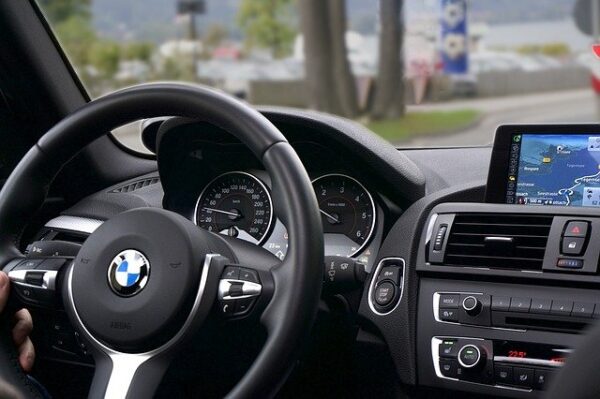
What Does ‘Cutting Corners’ Mean?
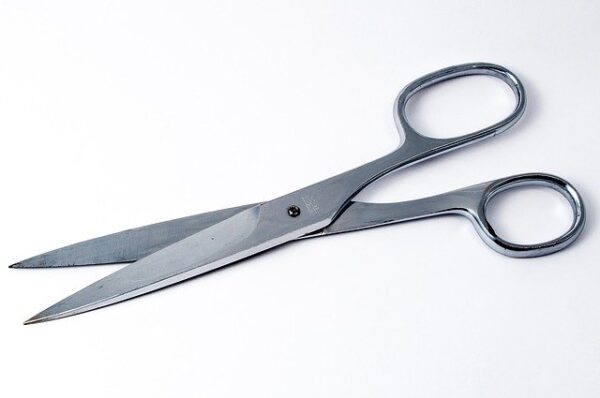
Yes, if you are turning corners and your turns are ‘not wide enough’ it means that you possibly ‘cut the corner’ or did not move far enough forward into the intersection before starting to turn the wheel.
So, your car was touching parts of the pavement that are generally frowned upon in relation to the direction you were traveling at that moment, if you know what I mean (wow, so diplomatic.)
Diagram Of Cutting The Corner
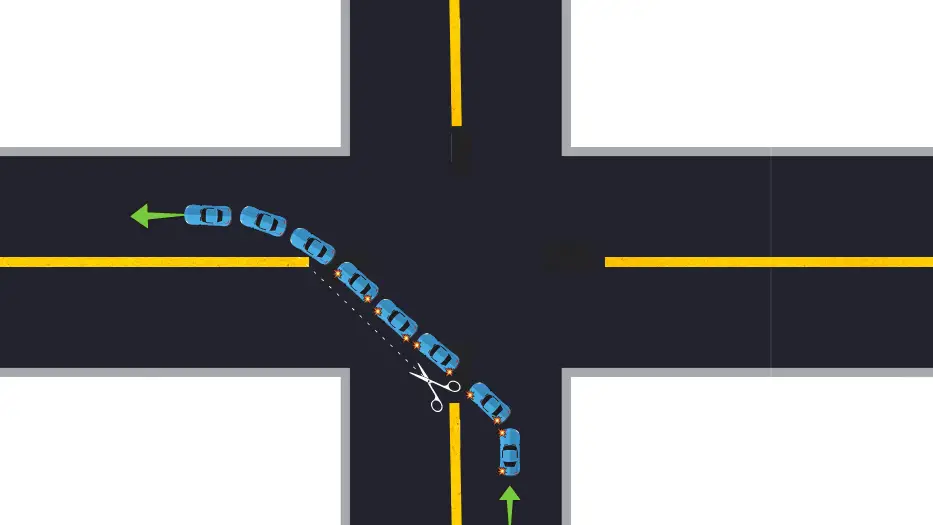
What Is a Wide Turn?
Sometimes when people are talking about turning corners you hear them talk about a wide turn. The following diagram is showing a wide turn.
This is wide, very wide, way too wide… unless you’re driving a semi-truck or other large vehicle, and by large vehicle no I do not mean your SUV!
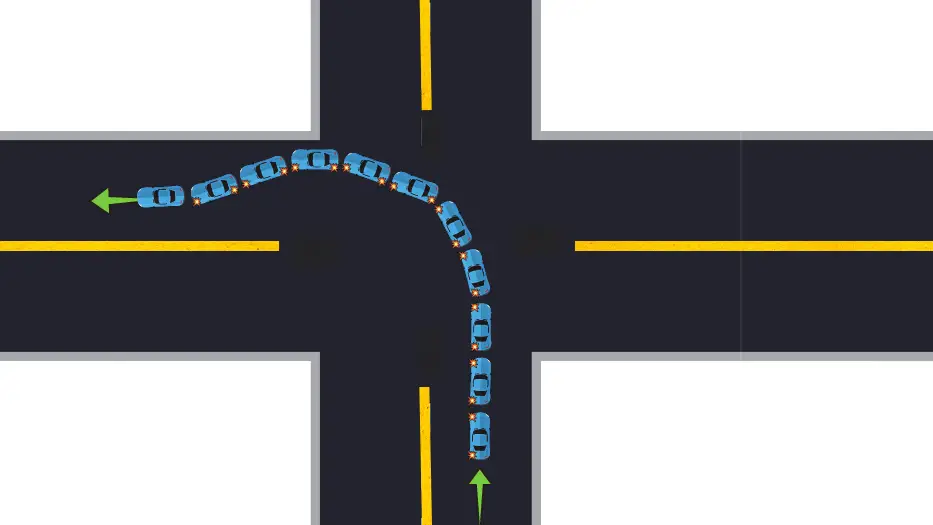
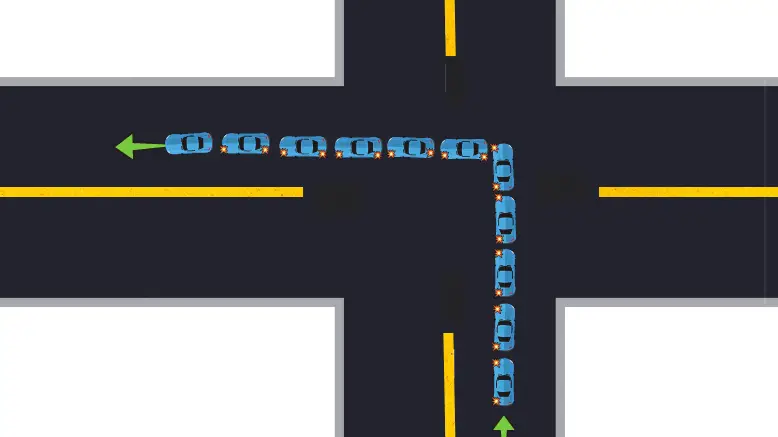
Trucks Have To Turn Wide

Trucks don’t have a choice
Keep in mind that when turning corners, large trucks do need to turn wide, depending on the size of the truck and the size of the intersection.
This is true especially when turning right. They must turn wide; otherwise, they will not be able to complete their turn without hitting stuff.
Read more: Be Truck Aware – British Columbia Government Website
Why Are Some Turns Wide Or Cutting Corners?
Warning: Entering deep into a driving instructor’s brain
Don’t say I didn’t warn you
There could be many reasons why people cut corners or turn wide. Sometimes people do it on purpose, but that’s a story for a different day.
New drivers are new at driving. (Duh) So, they haven’t yet learned how turning corners really works, or how to do a proper turn, especially if no one has taught them how.
Turning corners is actually one of the most difficult things to learn (and to teach) and that is a true story.
And a lot of teachers and parents don’t actually know how to teach turning corners because they ‘just do it.’
They have been doing it so long, they don’t even know what they’re doing. This doesn’t tend to help you when you’re new at driving. Especially if it’s your first time ever driving a car.
Reasons Why Your Turn Might Be Wide Or You Might Be Cutting The Corner
Problem #1: Not Looking Where You’re Going While Turning
You aren’t looking where you are going while turning corners. This sounds so basic, but it is a huge problem for new drivers
For example, many new drivers when they’re turning left, instead of looking at where they’re going while they’re turning, are still looking at some oncoming traffic that is down the road.
If you’ve decided to turn, then you’ve decided it’s safe to turn in front of that traffic; so what’s the point in staring at it anymore?
It’s not like you can turn halfway and then press pause and re-evaluate your decision. Wouldn’t that be nice, though?
So essentially, you aim your car where you look. If you’re still looking at the oncoming traffic while turning left, then your car will tend to aim toward the oncoming traffic. This results in a wide turn. Read more about how to drive your car in a straight line and where to look.
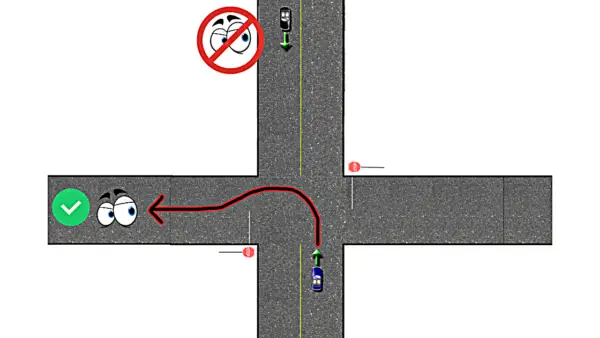
Problem #1: What to do about it –> Look where you want to go & then go there
It is normal for new drivers to have issues with their decision-making skills in general, but especially for turning corners. A lot of new drivers want to consider an option for a long time.
Once they have considered their options for a long time, the scene is completely different, because cars are moving things. How annoying is that?
Simply making a safe decision to turn when you see a safe gap in the traffic, and then looking where you want your car to go is the solution here. Looking at where you’re going is a specific and special and highly important skill that must be learned and practiced and improved.
The two most difficult things to teach a new driver
- Where to look
- How to make decisions
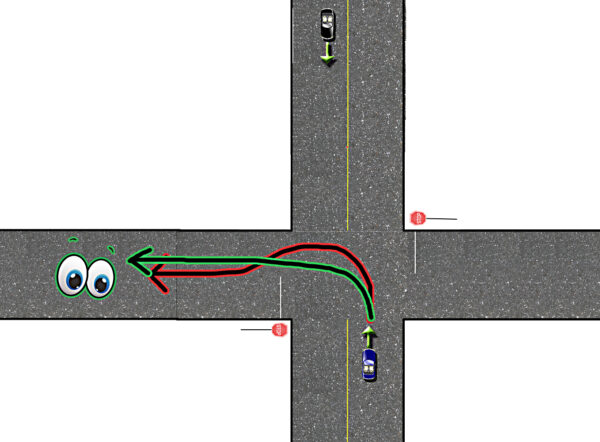
If you have problems with decision-making, maybe practice watching your teacher while they are driving. If you can see what they can see, try to guess when they will turn and see if they turn when you think they will.
Problem #2: Turning Your Steering Wheel ‘Too Soon’
If you turn your steering wheel too soon – before your car has reached an appropriate part of the intersection/road – this is when we have the ‘cutting the corner’ problem.
If you do this on a right turn, you run the risk of hitting the curb.
Sometimes, it seems like new drivers forget that their car has 4 wheels; the front 1/2 of the car makes it around the corner but the rear wheels don’t. The rear wheels make contact with the curb.
If you do this on a left turn, it means your car is traveling over a section of the wrong side of the road. Obviously, this is potentially dangerous if there is traffic coming there.
Problem #2: What to do about it –> You need to go forward a bit more before you start turning
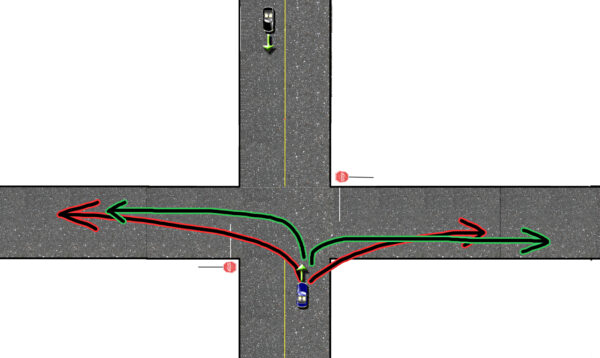
Problem #3: Turning The Wheel ‘Too Late’
When turning corners, your turn will be wide if you turn the steering wheel too late. What is ‘too late’? Basically, your car has already gone too far past the point where you should have turned the wheel. (Keep reading)
If you do turn the steering wheel ‘too late,’ then you often have no choice but to then turn the steering an additional amount just to get around the corner.
Consequently, you’ll need to un-steer it that amount on top of the required amount, in order to make it around the corner without ending up on the wrong side of the road.
This is a ton of extra and unnecessary work! Driving should not be that much work.
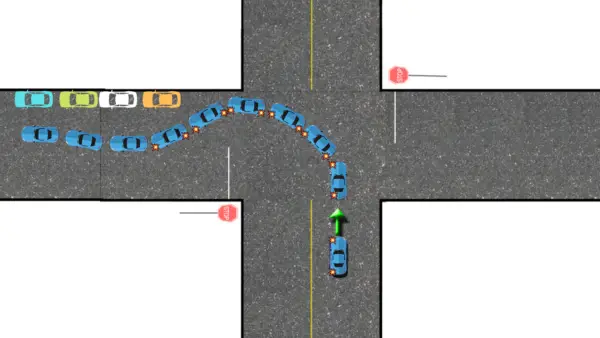
Problem #3: What to do about it –> You need to start your steering earlier and/or do not go that far into the intersection before turning (see below)
Problem #4: The Amount Of Steering Is Incorrect
Sometimes new drivers do this thing where they turn the steering wheel not enough / not the correct amount when turning corners.
For the typical right turn or left turn, you will need to turn the steering wheel less than one full circle (one full rotation.) More than a semi-circle, but less than a full circle. There is a magical amount, and it will be very similar for each corner, as long as the 90-degree turning angle of the typical corner is consistent.
Not that you are going to stare at your steering wheel when you’re turning. However, it’s good to take note of the emblem when you’re first learning. This can help you judge where the ‘top’ of your steering wheel is as a reference point.
Roughly How Much Steering Is Needed For A Typical Right Or Left Turn
Many new drivers, when turning corners, do “too much work,” more work than is needed to get the car around the corner. Not that you want to stare at your steering wheel when you’re driving, but it’s good to know roughly how much you should be turning your wheel to get around the corner.
Normally, it will be less than one full rotation of the steering wheel. Think three-quarters, or in and around there. Almost a full rotation.
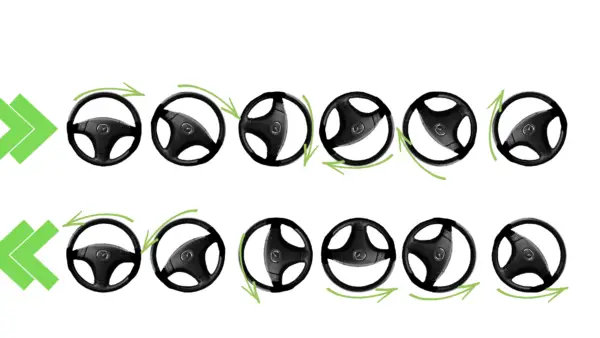
If you have a hard time with this, you could add a sticker to the top of your steering wheel.
This might still confuse you, but it may help with understanding where the ‘top’ is and how much more or less steering you need for any particular corner. Racing drivers sometimes do this so they can be sure where the top centre is from their peripheral vision.

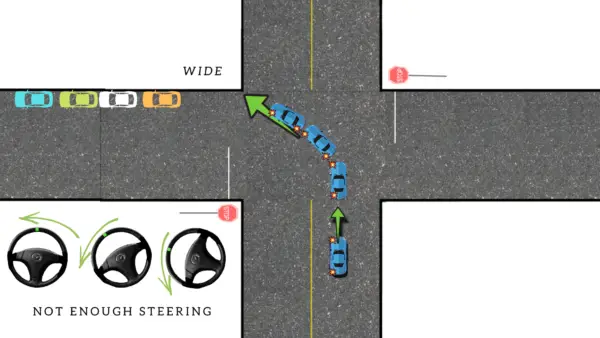
Problem #5: Incorrect Speed Of Your Turn
You may have issues with your vehicle speed relative to your ‘steering speed.’
If your car is going so fast that you don’t leave yourself time to turn the wheel enough, then that’s not going to work. Why is this getting so complicated?
Problem #5: What to do about it
This is one of the reasons why we recommend that all drivers slow to 20 km/hr before turning corners, no matter what the circumstance.
Likewise, if you’re so new at driving that your car is proceeding like a snail, then you’ll also need to turn the steering wheel perhaps more slowly.
If you get all the steering done when the car is stopped, that might not work either. This is because you might have turned it too early or not at the precisely correct time.
Normally we don’t turn corners while stopped. Or in other words, we don’t turn the steering wheel while the car is stopped and then expect to make it around the corner.
But some new drivers turn the steering wheel when the car is stopped, and then attempt to magically make it around the corner.
This is why it’s much easier to turn corners while your vehicle is moving slowly, but not too slowly.
If your vehicle is proceeding as a snail, then your steering wheel needs to proceed as a snail as well. If that makes any sense.
Many Factors Go Into Turning Corners
So you see, I just made turning corners sound a lot like rocket science. Which it kind of is, until you do it so many times that you don’t know what you’re doing anymore, just like everyone else.
Even though it would seem like one of the easiest driving maneuvers, it’s actually one of the most difficult to learn and to teach.
But, once you’ve got it then you can continue learning and everything else should be relatively easy to learn because you have this very important foundation.
If all else fails and you’ve been trying so hard on your turns and they just aren’t working.. this will sound strange but simply stop trying for a while.
Just look where you want to go and forget the rest. Sometimes this works well for people who tend to over-analyze things.
Correct a.k.a. ‘Proper’ Turning Corners
Let’s get proper!
Turning corners seems like a simple thing to do. But, it’s one of the most difficult for new drivers to learn.
It’s difficult for people to teach as well because experienced drivers ‘just do it,’ they don’t even know what they’re doing to the point they could explain it to someone else.
Not sure I have the best way of explaining it but will try. Anyway, keep practicing the turning.
They get better if you keep working on them.
Issues Turning Corners – What To Do
When you are planning a turn, you should always check out where your car is going to end up after you turn. Where exactly are you going?
This is one of the first things you should do every time. This alone will help with the problem.
Of course, you want to do this anyway for other reasons. For example, ensuring there is actually a space for your vehicle to fit once you turn i.e. it’s not backed up with traffic or there is a crash there.
Where Exactly Is Your Car Going To Go, Anyway?
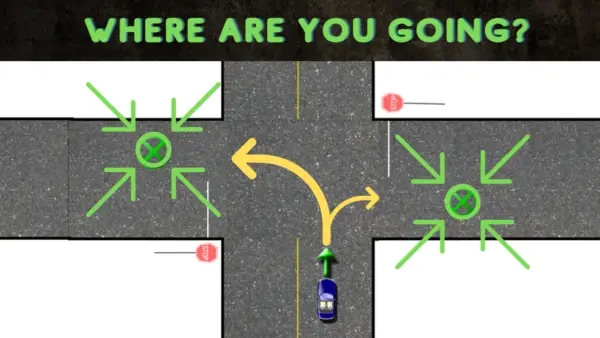
There are so many different sizes of intersections with different amounts of lanes, different widths, and different features; and it is always important to check and see where you are going to end up after your turn.
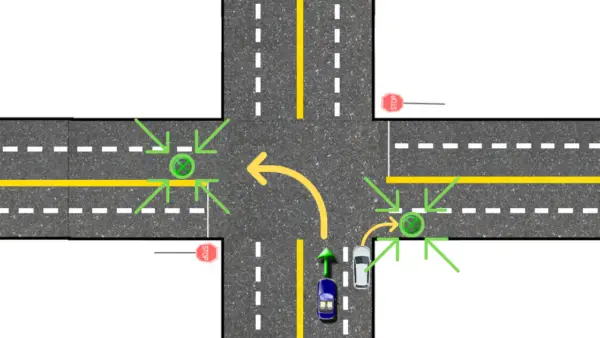
What Is The ‘Proper Amount’ To Pull Forward When Turning Corners?
Well, this is a bit hard to explain, but the thing to remember is you don’t want to pull forward ‘not enough’ and cut the corner, but you also don’t want to pull forward too far and do one of those funky wide turns either.
You Want To Pull Forward Enough That :
- You have a short and efficient turn into your new lane, with the minimum amount of steering possible.
- New drivers seem to feel that they should always be doing something. When it comes to steering, less is WAY more.
- Why do extra work?
- You also have to think about not pulling in so far that you’re getting in the way of an opposing left-turning vehicle when turning left.
Turning Corners – Picture 3’s For Every Intersection Left Turn
They say good things come in 3’s
For left turns, generally, I would recommend chopping the road into 3 chunks inside your imagination. Pull forward about 1/3rd, so your front bumper is roughly up to the 1/3 area.
It doesn’t have to be exactly perfect, you don’t have to get out your measuring tape and measure it or anything like that, but roughly around this area will set you up nicely for a good turn.
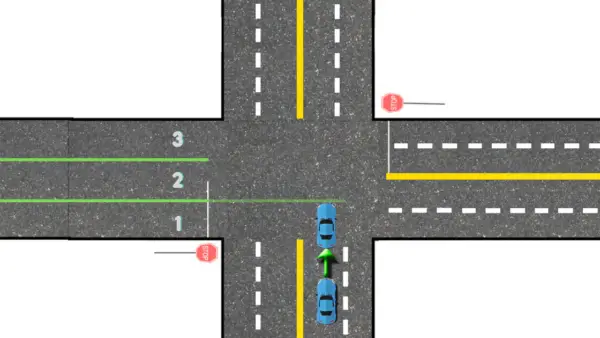
Turning Corners When You’re Turning Left
Sorry for my questionable Photoshop skills. As you can see below that the car has pulled forward roughly just to 1/3rd of the intersection.
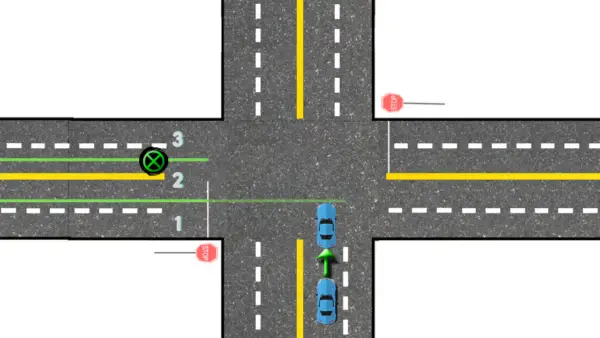
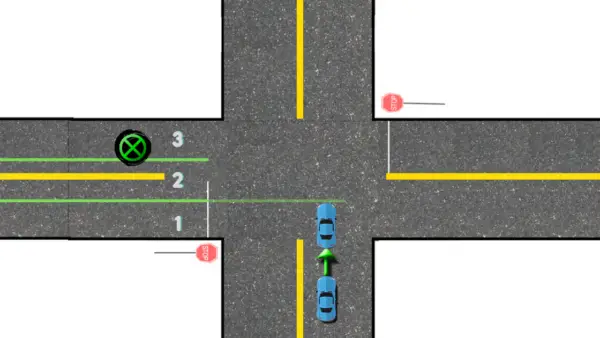
If you pull forward roughly this amount, and the car facing you does as well, then you will both have enough room to complete your left turns simultaneously.
Sometimes it is safe/possible to turn at the same time. All the details about how to turn left at a traffic light are here.
You each have a lot to focus on when turning left; you don’t want to be getting into each other’s business.
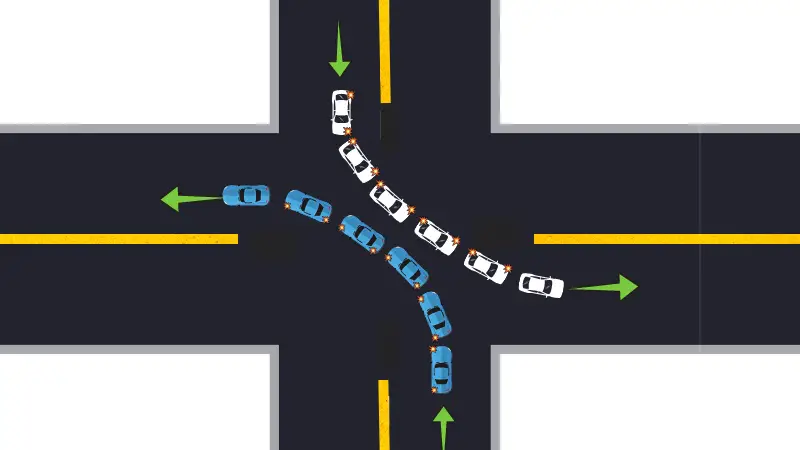
Look Where You Want To Go
The other insanely important thing about turning corners is to look where you want to go.
This may sound obvious. But a lot of brand-new drivers (dare I say ALL) are still looking at other things while they are turning.
They are not actually looking in the direction their car is going, or where they would like their car to go, while they are turning.
What to do about it…
The trick is to do any kind of checks, or observations, or look for pedestrians and oncoming traffic before you turn.
Once you have made that decision that you’re going to turn, then you must look where you want the car to go and then magically go there.
Do keep your eyes moving while driving. But for sure look far ahead at where you want to go while turning.
Remember that you can still see the other cars in the corner of your eye. There is no need to stare at them!
A lot of new drivers are nervous about running into parked vehicles when they’re turning left.
However, if, in the middle of your turn you decide to stare at the parked vehicle, then you will probably drive right into it. Just an FYI.
Remember that parked cars are parked. Most of the time they will probably not jump out at you while you go past.
You can still see them in the corner of your eye, so look ahead, far, far, far, far ahead at where you would like your car to go.
Ask Yourself These Questions While You Are Turning Corners
- How many intersections can I see up ahead?
- How many traffic lights or stop signs can I see up ahead?
- What is the farthest point that I can see far up the road?
This is the kind of thing to ask yourself as a reminder to keep your eyes ‘up,’ where they belong
Many people – even experienced drivers – tend to stare at the pavement in front of their bumper while driving. Or, stare at the car in front of them. Be sure to avoid this terrible habit.
Pavement doesn’t tend to jump up and bite you (unless… never mind lol!) And when you look far into the distance up ahead, you’re still able to see the car in front in your peripheral vision, right?
The Other Problem With Turning Corners: Steering Issues
The actual steering technique could be the other problem with turning corners if a new driver hasn’t learned proper steering techniques. Or, if you haven’t mastered the proper amount required for a regular left or right turn.
New drivers need to realize that it is possible to turn the steering wheel way more than is needed for a turn. If you turn it extra, you are doing extra work, which will make it extra difficult.
3 Steps To A Good Turn
Here’s the basic prescription for turning a corner
- You need to turn the steering wheel a specific amount at the beginning of the turn. The specific amount is not a full circle of the wheel, but usually about 3/4 of a full rotation.
- You then need to HOLD the wheel there and simply DO NOTHING while the car turns. It is hard for student drivers to do nothing as it’s easy to think that you should always be doing something. This is not the case. Embrace the nothingness.
- Slowly un-wind, or undo, the wheel while looking far ahead of course.
Conclusion
Turning corners left and right is the most difficult thing to learn for a new driver, and it’s also the most difficult thing to teach, even for driving instructors. This is a very true story.
When my mentor at the driving school where I worked, was teaching me how to become an instructor, he asked me to explain to him as the pretend student driver, how I turned a corner. Like, what were the steps? What did I actually do?
Even though I consider myself at least moderately intelligent, I couldn’t answer the question. I had absolutely no clue what I did to actually turn left and right. It magically just happened.
It just so happens that it must be the first thing to be learned. Well, one of the first, anyway, because in my experience, you can only go straight for so long.
The other disadvantage of corners is that the new driver and their copilot tend to be the most nervous. Finding a quiet place to practice is very important here. Make sure to avoid areas with those little residential traffic circles. Those are extremely difficult for a brand-new driver and require a lot of steering and skill.
So to any new driver struggling with this, just know that this skill is simply hard. After more experience, they will get easier. And after that, everything else is so much easier to learn, even backing up and parking. So just be patient working through it because it does take a long time. Perhaps up to 20 hours of driving if you’re keeping track. (Which is a good idea, 60 is recommended before the test).
Turning Corners – Recommended Resources To Dig Deeper
Just in case this wasn’t deep enough. Preparing for your ICBC road test? Be sure to check out my epic article: ICBC Road Test Tips For Classes 5 & 7 [Instructor Gets Deep].
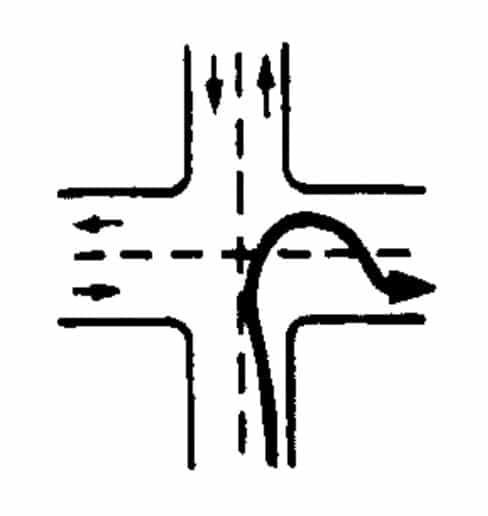
Thanks its very helpful. I wished there were more discussions about turning right especially as this has been one of the more difficult area for me. Earlier today i was too near the corner and turned earlier for fear of getting in the incoming driver’s lane. Well I hit part of curb. I wanted to know the safe distance where i should be when turning right.
I’m going to make some new videos soon.
Lovely to see your effort in here on this very imp yet less talked about topic. The diagrams which also at one place you mentioned are photoshopped by you really makes understanding easy. Kudos for that! Keep up the good work. :)
Ohh thank you for the comment!
Hi Carmen, just wanted to thank you for such useful website!
you’re very welcome